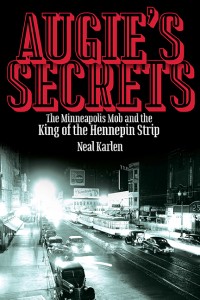What We’re Reading: Augie’s Secrets

 Augie’s Secrets: The Minneapolis Mob and the King of the Hennepin Strip, by Neal Karlen (Minnesota Historical Society Press, 2013)
Augie’s Secrets: The Minneapolis Mob and the King of the Hennepin Strip, by Neal Karlen (Minnesota Historical Society Press, 2013)
St. Paul’s Police Chief John O’Connor protected gangsters during Prohibition. For a small fee, O’Connor looked the other way as long as they left the city before abducting political candidates and burying the evidence. I know this because Neal Karlen knows this. Karlen knows this because his father knows, and his father knows because his uncle, Augie Ratner, was the unofficial mayor of downtown Minneapolis. Through the 1950s, the Jewish mafia ran rackets across the Twin Cities, and Augie was their best friend and confidant. In the loving biography of his faith and family, Augie’s Secrets: The Minneapolis Mob and the King of the Hennepin Strip, Karlen upholds his great uncle’s crown as the King of Hennepin Avenue.
As an adjunct professor with the University of Minnesota, Karlen has written for The New Yorker, GQ and Rolling Stone. Along with writing eight books, Karlen’s also a regular contributor to The New York Times. In 2008, William Morrow published Karlen’s study of the Yiddish language, and this passion for his heritage rings through Augie’s Secrets. Using slang like he’s back at the club, Karlen sometimes can’t slow down to explain what farbisseneh means because he’s telling you about the time boss Davie Berman broke up a pro-Nazi rally at the Minneapolis Elks Lodge.
Augie wasn’t a gangster, but they all came to his club. In the ’30s he opened Augie’s Theatre Lounge on Hennepin, featuring live music and burlesque entertainment. He checked guns at the door, and kept a space in the back lot with a bright light for fighting. Augie knew John Dillinger; they even liked each other. He knew Jimmy Hoffa, Bugsy Segal, and the local boys Isadore “Kid Cann” Blumenfeld, and Davie Berman, who eventually helped Las Vegas become Sin City. Augie gave people a place to hide away from cops, lovers, and debt collectors. Today we know Augie’s as that strip club over on Hennepin, but during the years around Prohibition, with corruption on the streets and in the capital, Augie’s was a haven for people to shed their lies.
As Karlen tells it, Augie knew where the bodies were buried. He knew whose blood stained the money, he knew what the Mayors couldn’t tell the press, and he knew all his neighbors. Every day Augie rode his bicycle around Lake of the Isles while smoking a cigar and waving to families on his way to hear another confession.
Augie played no other angle except that of friendship. He asked only that he be allowed to play the good, always friendly, sometimes buffoonish character he was —but he was aware of everything.
And now we are aware of everything. But when our friend Augie welcomed strangers with a drink and a smile, no one could see his mask. As loyal friend and studious businessman, Augie lived along the line between outlaw and lawman. Hardened by the popular bigotry of Minneapolitans, some of the most powerful Jewish gangsters fought to kill. When the publisher and anti-semite Walter Ligger tried to extort Kid Cann, the Kid gunned him down while unloading the groceries with his family. Karlen found the Kid’s alibi.
Kid Cann said he was “getting a shave and a manicure, just like he did every day, from Dave Garfinkle at Garfinkel’s Artistic Barber Shop, just a few feet away from Augie’s joint. Garfinkle swore it was true. But it wasn’t. At the time of the murder, Dave Garfinkle was cutting Augie’s hair.”
Augie’s Secrets reads like a transcribed monologue, with Karlen acting out all the parts. You open the book and he’s invited you over for drinks to tell you the secrets of his family. In 1943, Augie sat in his club with John Roberts, an FBI special agent, and Bill Stern, the owner of the Dakota National Bank in Fargo and a leader of the Republican National Committee. Also seated was James Francis Keating, one of the most notorious bank robbers of the 1920s. Only Augie knew Keating as Jimmy, the reformed Minnesota man just released from Alcatraz. Karlen recalls his family history with impressive detail:
Augie: Bill, I don’t think you’ve met our friend Jimmy Keating. Jimmy, Billy is a banker in Fargo.
Jimmy: What bank, Bill?
Bill: I’ve owned the Dakota National Bank for many years.
Augie: Jimmy, have you ever done business up there?
Jimmy (pausing): The Dakota National? Oh yes, I know it well.
Jimmy had, in fact, knocked off Bill’s bank a generation before —and gotten away with it. Augie grinned and relit his cigar.
Though his writing captures the danger and excitement of a lawless America, Karlen disturbs the pacified notion of Minnesota’s Nice Culture. Our Twin Cities developed through the post-war boom with pervasive corruption and anti-semitic rage. To read this book is to bear the weight of our shared history. With the rigor of a scholar and the honesty of your closest friend, Karlen challenges us to consider the lives we all carry quietly behind our eyes.
Sometimes you find words that hit you in the gut and fit you like a new pair of glasses. What the last book you read that changed the way you see your city?






Comments are closed.